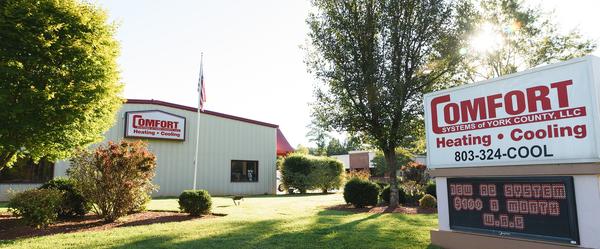Central HVAC Units vs. Ductless Mini‑Splits

If you need a new HVAC system for your home, you might be wondering about the difference between central heat and air vs. ductless mini-splits.
Ductless systems have gained popularity over the last decade, particularly for their versatility, high efficiency, and ease of installation. However, central heat and AC systems have many of their own benefits to consider, including greater capacity, air filtration, and aesthetics.
To help you understand the differences between the two and help you make an informed decision suited to your needs, comfort, and budget, we’ll delve into:
Rather speak to a trusted HVAC professional? Call Comfort Systems of York County at (803) 324-7572. Our licensed and experienced technicians will walk you through all of your heating and cooling options— including upfront pricing and financing plans available. You can also schedule a free in-home estimate directly through our website!
The Benefits of Central Heat and AC
Central heating and cooling systems are often referred to as “forced air.” This is because they rely on a network of pre-installed air ducts to push air throughout your home.
There are many benefits of this traditional type of HVAC system, including:
- The ability to handle extreme cold. With a ducted airflow system, you have the option to install a furnace and AC together. During winter months when temperatures can drop below freezing, having a furnace that can put out substantial heat is a nice benefit. All the more so if you prefer a very warm home.
- Better air filtration capacity. With central heat and air, you have the option to install air purifiers directly within your ductwork. That way, as air passes through your ducts, you can eliminate even the tiniest of particles from circulating in your home. If your household suffers from asthma or allergies, this can be a huge plus.
- No visible indoor equipment. With a central air system, your air vents are the only visible parts you’ll see around your home. If design and aesthetics are important to you, not seeing bulky equipment may impact your choice of an HVAC system.
The Benefits of Ductless Mini-Splits
As the name suggests, ductless mini-splits don’t require ductwork to operate. Instead, they employ individual air handlers that you can place in various rooms throughout your home.
There are a number of benefits to ductless mini-split systems, including:
- “Zone” temperature control. If you’re looking to control the temperature in specific areas of your home (such as a back bedroom or home addition), installing a ductless mini-split will allow you to set precise temperatures through a convenient remote control. And although you can achieve zoning with a central air system, too, a ductless mini-split makes it cheaper and easier to do.
- Energy-efficient. In general, ductless mini-splits are more energy-efficient. Rather than heating or cooling your entire home, you can focus on specific rooms only. Additionally, you don’t run the risk of conditioned air escaping through leaky ductwork. A ductless mini-split may be the more affordable, long-term option if energy bills are a concern for you.
- Quick and easy to install. Ductless mini-splits can be installed in as little as one day. All that’s required is an outdoor unit and however many indoor air handlers you choose. If you don’t want to deal with the hassle of a major installation, a ductless mini-split is highly convenient.
Cost Difference Between Ductless Mini-Splits and Central AC/Heat
In general, ductless mini-splits are less expensive to install.
Harnessing the power of a dual split heat pump, you can both heat and cool your home— all through one outdoor unit— for an average of $7,200.
Comparatively, if you were to install a furnace and AC (central heat and air system), you can expect to pay an average of $12,000.
Ductless mini-splits require individual air handlers in each room of your home. So if you need more handlers, your costs will increase.
Which Option Might Be Best for Your Home
Choosing the right HVAC system for your home comes down to your comfort preferences, current infrastructure, and desired budget.
To help narrow down the choice, ask yourself questions like:
Do you already have air ducts installed? Ductwork can cost upwards of $4,500, so if you don’t have any installed and it’s not in your budget, central heat and air may not be cost-effective.
Are you looking to heat or cool only one specific area of your home (e.g., granny flat, new addition, or bonus room)? If so, a ductless mini-split may be the ideal option. Not just for your budget, but also for speed and ease of installation.
How cold is your area in the winter? Once temperatures drop below freezing, dual split heat pumps stop performing at full capacity, and you’ll likely need an auxiliary heat source. In this case, you might want to consider a furnace and central AC system.
If you’re still not sure, speak with a licensed HVAC contractor in your area. Once they understand your needs and budget, they can provide expert recommendations tailored to your unique circumstances.
Want a Fixed-Price Quote for a New Heating and Cooling System? Contact Comfort Systems of York County
Since 1955, we’ve been York County’s choice for honest advice, upfront pricing, and 5-star quality HVAC installations, repairs, and maintenance. To get a fixed-price quote on a new heating and cooling installation, give us a call at (803) 324-7572 or book a free in-home estimate directly through our website. We’ll review your home’s size, layout, and energy requirements, and then provide multiple system options best suited to your needs and budget.